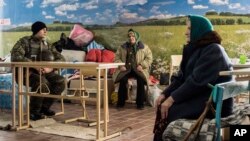As Ukraine enters its fifth winter of conflict, the United Nations says civilians continue to be victimized by widespread human rights violations and abuse perpetrated by both the government and Russian-backed rebels in Donetsk and Luhansk in eastern Ukraine. The report issued by the U.N. Human Rights Office covers the three-month period between mid-August and mid-November.
Ukraine's civil conflict, which began April 2014 appears to be at a stalemate. However, this has not stopped the warring parties from subjecting the civilian population to gross violations of human rights on both sides of the contact line. This refers to the 500-kilometer line of separation between Ukrainian forces and Russian-backed separatist rebels.
The U.N. has documented hundreds of abuses of the right to life, deprivation of liberty, enforced disappearance, torture and ill-treatment, sexual violence, and unlawful or arbitrary detention.
The report describes the hardships endured by the population due to Ukraine's worsening economic situation. U.N. Deputy High Commissioner for Human Rights, Kate Gilmore, said large segments of the population suffer from the socio-economic barriers created by the armed conflict. She said the elderly, children, disabled people and those displaced by the conflict are particularly vulnerable.
"Disproportionate restrictions on the freedom of movement along and across the contact line continue to disrupt people's access to social entitlements, such as pensions and social benefits. This in turn unduly impedes their access to basic services, those that are essential for daily dignity, including, for example water, sanitation, heating and health care," she said.
The U.N. report harshly criticizes Russia for continuously violating its international obligations as the occupying power in Crimea.
It documents dozens of human rights violations including stifling dissent, instilling fear and denying individuals their freedom of expression, association, and peaceful assembly. It notes Crimean Tatars are disproportionately affected by these measures.





